{{ getArticlePackageHeading(article.package_id) }}
{{ getArticlePackageMessage(article.package_id) }}
{{ getUpgradeMessage(article.package_id) }}
Upgrade Now
5 Best Omnichannel Ecommerce Platform Development Companies to Enhance Your Business
{{post.p_details.text}}
Let’s start with a common scenario: your customers are trying to reach you through various platforms. To make it convenient for them, you offer multiple communication channels for your eCommerce business, such as your website, mobile app, text campaigns, and social media platforms. Some customers engage with you on your website, others on your mobile app, and a few on social media.
However, you will only be able to provide a unified and consistent experience if these communication channels are interconnected. This inconsistency can lead to frustration and dissatisfaction among your customers, as they expect a seamless transition between online and offline interactions. Also, without omnichannel integration, managing inventory across multiple channels becomes complex. This can result in stockouts, overstocking, and difficulties in fulfilling orders, ultimately impacting customer satisfaction and profitability. This is where omnichannel eCommerce comes into play.
What is an Omnichannel E-commerce?
Omnichannel retail, or eCommerce omnichannel, refers to a sales approach that utilizes multiple channels to deliver a unified purchasing experience to customers.
This seamless experience is maintained across all channels, whether customers shop in-store, online, through mobile apps, or other digital platforms. Omnichannel eCommerce may include online storefronts, brick-and-mortar stores, marketplaces, Instagram eCommerce, and other social media-supported stores.
Having a strong omnichannel eCommerce strategy focuses on the entire buying experience of the customer not just the individual experiences on different channels. The final purchase decision happens based on the information collected by the consumers from different sources.
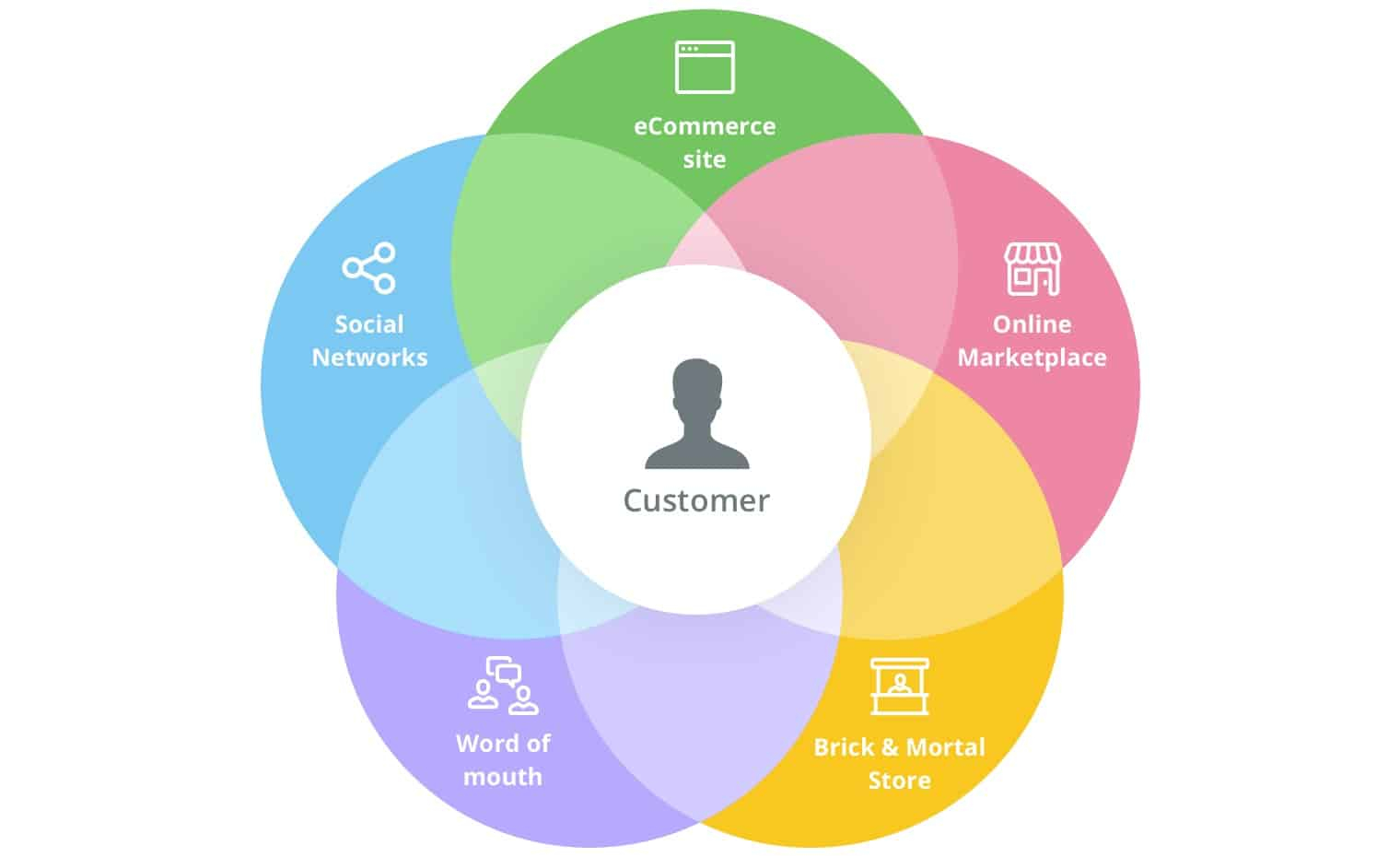 SOURCE: REVE CHAT
SOURCE: REVE CHAT
5 Essential Benefits of Omnichannel eCommerce
1. Meet customers’ expectations.
McKinsey & Co.’s recent omnichannel survey revealed that eCommerce sales routes are the most successful for 41% of leaders, surpassing in-person (37%) and video (31%).
Almost all respondents predicted they would be able to produce physical sales by the year’s beginning, yet only 15% of B2B merchants look forward to this being their primary method of engagement.
In the direct-to-consumer space, omnichannel expansion is the status quo even for digital-first (or digital-only) brands.
Warby Parker is an industry leader amongst DTC brands that are venturing into omnichannel, with its first physical store opening all the way back in 2013. Proving their commitment to success and growth, they opened 40 new stores just last year.
For the third quarter of 2022, another remarkable metric was noted at the eyewear brand: On average, per-customer revenue catapulted to an all-time high of $258—up 7% from last year.

SOURCE: DECISION RESOURCES.INC
2. Price flexibility
Your customers aren’t looking for you. And if they are, they don’t want to look very hard.
A stellar customer experience trumps a higher price in many cases, according to PwC research. 43% would pay for greater convenience, 42% for a friendlier, more welcoming experience, and the vast majority for personalized customer support.
An omnichannel eCommerce strategy enables organizations to do just this—providing customers with the option of tailored pricing and product recommendations alongside convenient payment options, no matter where they are located.
3. Optimal inventory management
Stock control is tricky for several reasons: It requires a deep understanding of customer behaviour, supply chain management, and demand forecasting to ensure you’re not overstocking or understocking any items.
By utilizing omnichannel systems to share stock data, your business can significantly reduce the risk of stagnant inventory that goes unsold – thus minimizing storage and opportunity costs—as evidenced by prominent retailers like Coach, Kohl’s, Best Buy, Sears, Macy’s, and Walmart, which deploy an “endless aisle” concept in their brick-and-mortar stores.
Using this strategy, customers can browse online inventories with items available for delivery or pick up at different locations, making cross-channel inventory management a highly effective tool with vast implications for the business’s bottom line.

SOURCE: BORONG
4. Revenue growth for the company
Focusing on customer experiences has the potential to facilitate a massive return on investment.
Qualtrics research shows that companies with $1B ARR accumulate an average of $775 million when they prioritize the customer experience.
For smaller companies, it’s a life-or-death situation. Thanks to the Amazon effect and eCommerce usage at an all-time high, customers expect immediate gratification with their shopping experience.
Companies grow their revenue through their customer experience in several ways:
- Increased conversions. With a seamless experience across channels, customers are more likely to convert on their purchase.
- Repeat customers. Customers who have a better customer experience are more likely to buy from the same company again and again, meaning higher customer lifetime values.
- Increased loyalty. Satisfied customers are more likely to refer their friends, family and colleagues to the business, leading to a higher rate of customer acquisition as well as increased loyalty.
- Brand recommendations. Word-of-mouth marketing is a powerful asset for businesses, and customers are likelier to talk about companies with which they have a positive experience.
It certainly pays to invest in a customer-focused approach, and an omnichannel eCommerce strategy is the only way to truly do that.
5.Opportunities for upselling and cross-selling.
Cross-selling and upsell opportunities benefit both customers and businesses alike, providing the former with a tailored selection of products while allowing the latter to increase their average order size and revenue.
Cross-channel strategies provide companies with the opportunity to distribute targeted messaging to their customers through a variety of means, including email, SMS and social media.
For instance, in-store businesses can take advantage of ship-to-store features, which allow them to save on delivery costs while providing the potential for more in-store purchases (e.g., matching accessories).
The opposite is also true—retailers that are predominantly brick-and-mortar can take advantage of digital channels to recommend additional items, order out-of-stock inventory, and even provide payment options.
At the same time, online customers can be prompted to add items to their cart through personalized product recommendations.
5 ways to create an awesome omnichannel e-commerce strategy
1. Define your omnichannel customer journey
Every customer’s buying journey is unique, so it’s up to you to meet their expectations on their channel of choice. To do this, it’s useful to start outlining the potential routes they might take. Identify key stages in the omnichannel customer journey like research, consideration, purchase, onboarding, product adoption, and loyalty.
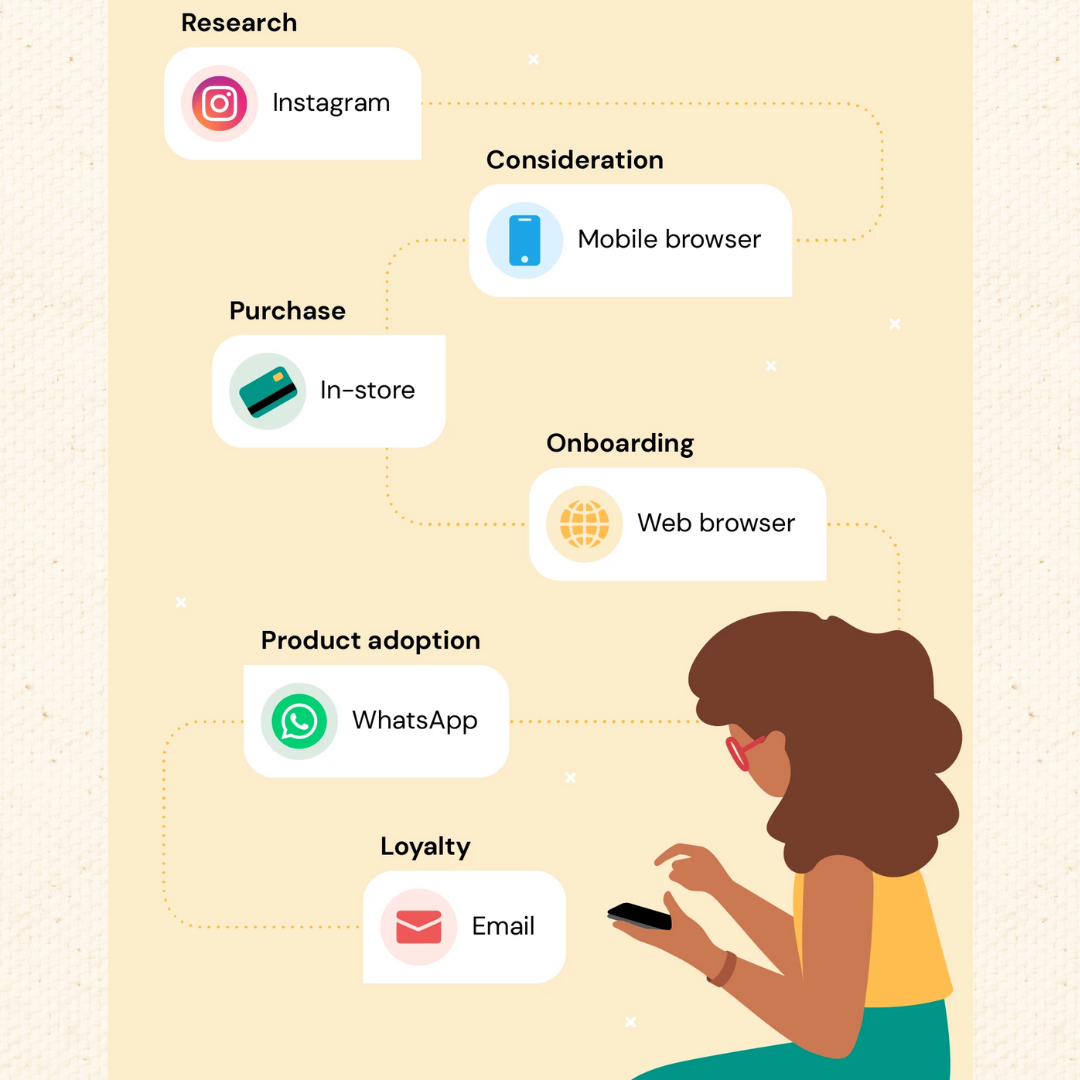
SOURCE: SNITCH.COM
Once you do that, you can start thinking about where people are interacting with you at each stage. For instance, they might discover your products on social media, do research on your website, buy via your mobile app, and then get post-purchase help via email. Understanding these touchpoints helps tailor your omnichannel strategy to make their experience better and make them more likely to convert.
2.Use channels that your customers already love
When choosing how to reach your customers, it might be tempting to stick with what you know. But the real trick is to choose the channels your customers love. Start by learning about your target audience and which channels they like. You can look at data like age, interests, and what they say in surveys to find out their favorite conversational messaging channels.
For example, if your customers are big on mobile messaging, think about using rich messaging channels like Rich Communication Services (RCS) and WhatsApp. These channels let you send interactive content like images, videos, or GIFs right to your customers’ phones. By picking channels your customers enjoy, you’ll grab their attention, and your messages will stand out!
3.Streamline your presence across channels
If your customer can’t be sure that you’re the brand they mean to contact, then your brand won’t be successful in building the trust needed to carry that customer through and make a purchase.
You can incorporate omnichannel marketing in your e-commerce strategy to make sure that your brand’s presence on different platforms will be consistent and recognizable. This could look like personalized messages, discounts, or customer loyalty programs tailored to unique preferences and behavior.
But don’t stop there! Considering expanding your reach into marketplaces like Amazon, Facebook, or Etsy. Having your customers purchase via other online channels or social media platforms can help you add customer touchpoints that eventually bring them to your website.
4. Personalize, personalize, personalize
We know by now that putting the customer at the center of the experience is the key to any successful omnichannel strategy. Each customer is unique, so you should aim to let them know that you understand their unique needs better than your competitors.
You can achieve this by personalizing your messaging through various channels. Use what you know about each customer to address their specific preferences and requirements. This will not only enhance the customer experience but set you apart from the competition.
Here’s a real-life example: Nissan Europe used a personalized SMS solution that could harness its CRM data to personalize its mobile messaging and target its customers wherever they were. As a result, they drove 4.7x higher engagement and an 80% conversion rate. That’s what can happen when you prioritize personalization in your omnichannel strategy!
5. Ensure five-star customer service
An omnichannel strategy revolves around putting the customer first, allowing you to understand their journey and needs while aligning your sales goals to them.
Focus on building trust and meeting the specific needs of each customer. Ensure you address the reasons why your customers choose your product, and leverage tools like conversational AI or live chat tools to boost customer satisfaction.
Want to see this in action? Luxury fashion house Zadig & Voltaire wanted to create a great customer care experience, so they implemented a solution to make its customers feel heard across channels, starting first the one million plus people following their Instagram channel.
Top 5 Omnichannel Ecommerce Solutions to Upgrade Your Business
Webnexs
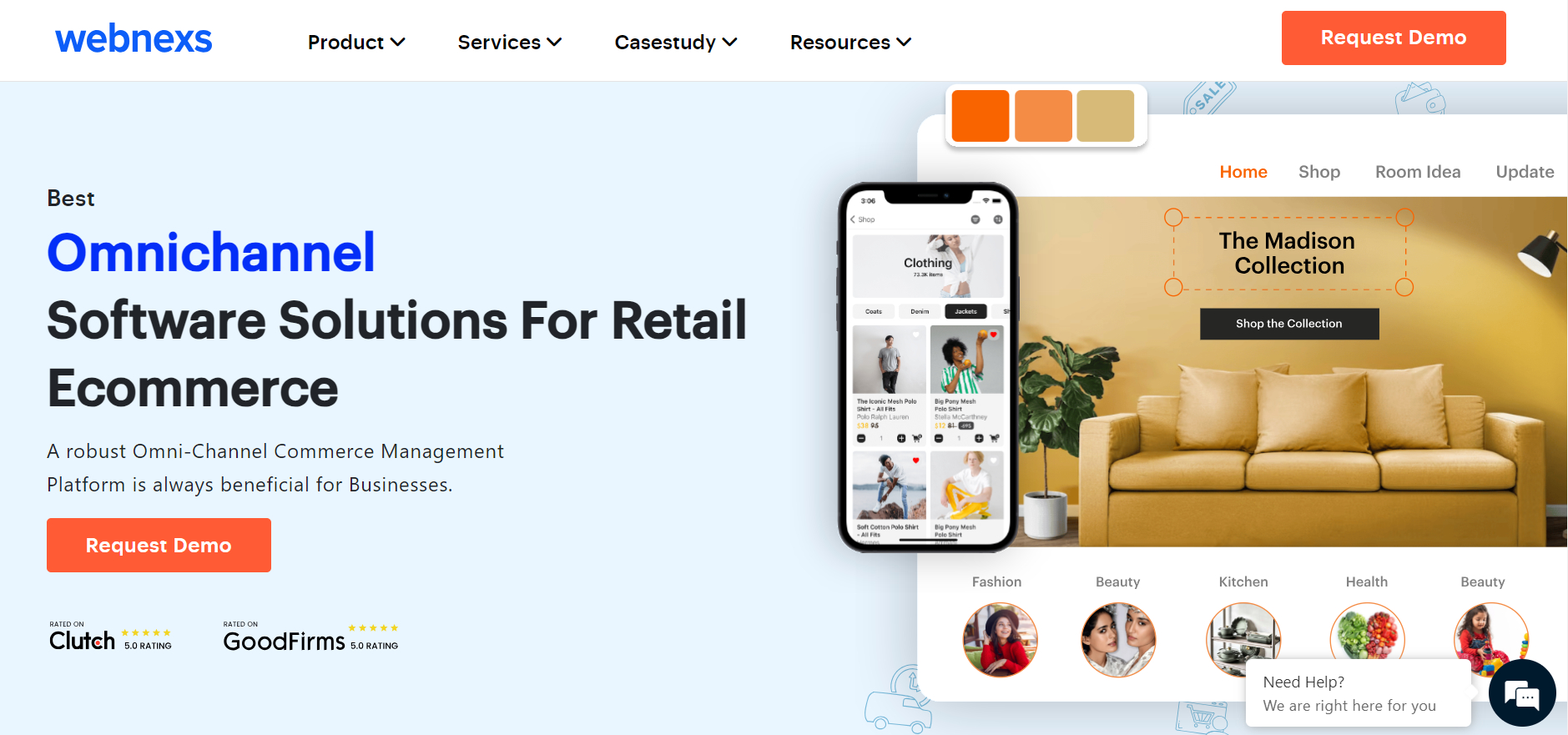
One of the top omnichannel ecommerce platforms, Webnexs is well-known for its easy integration and extensive feature set. It gives companies a complete solution for setting up and running their online storefronts and offers a consistent shopping experience across all platforms.
Features
Easy Shopping with a Built-In Buy Button
Simplify Buying with a Unified Wallet System
Grow Your Audience with Social Commerce Tools
Boost Sales with Unified Retail Software
Advanced Retail Control with POS
Wcart

Wcart provides omnichannel software that integrates sales channels for mobile, in-store, and internet. With just one user-friendly interface, our technology improves customer experiences, combines inventory management, and streamlines operations.
Features
Unified Dashboard: A smooth overview of operations through centralized control of mobile, in-store, and internet sales channels.
Real-time inventory tracking: To avoid stockouts and overstocking, automated inventory updates are made available on all platforms.
Customer insights: State-of-the-art analytics and reporting capabilities to help you better understand consumer behavior and craft marketing campaigns.
Omnichannel Communication: Software for handling support and customer contacts over several channels, including as chat, email, and social media.
Shopify plus

Shopify Plus enhances ecommerce with advanced features for business growth. It offers diverse sales channels, enabling broad market reach and optimized operations. The platform integrates product management, marketing, and customer interactions into a single hub. Automation tools like Shopify Flow streamline tasks such as inventory management and order processing, while Shopify Launchpad automates campaign and sale scheduling.
Features
Increased Personalization Choices.
Increased automation with Shopify Launchpad, Shopify Flow, and other products.
committed team of customer service representatives.
Create several stores.
BigCommerce
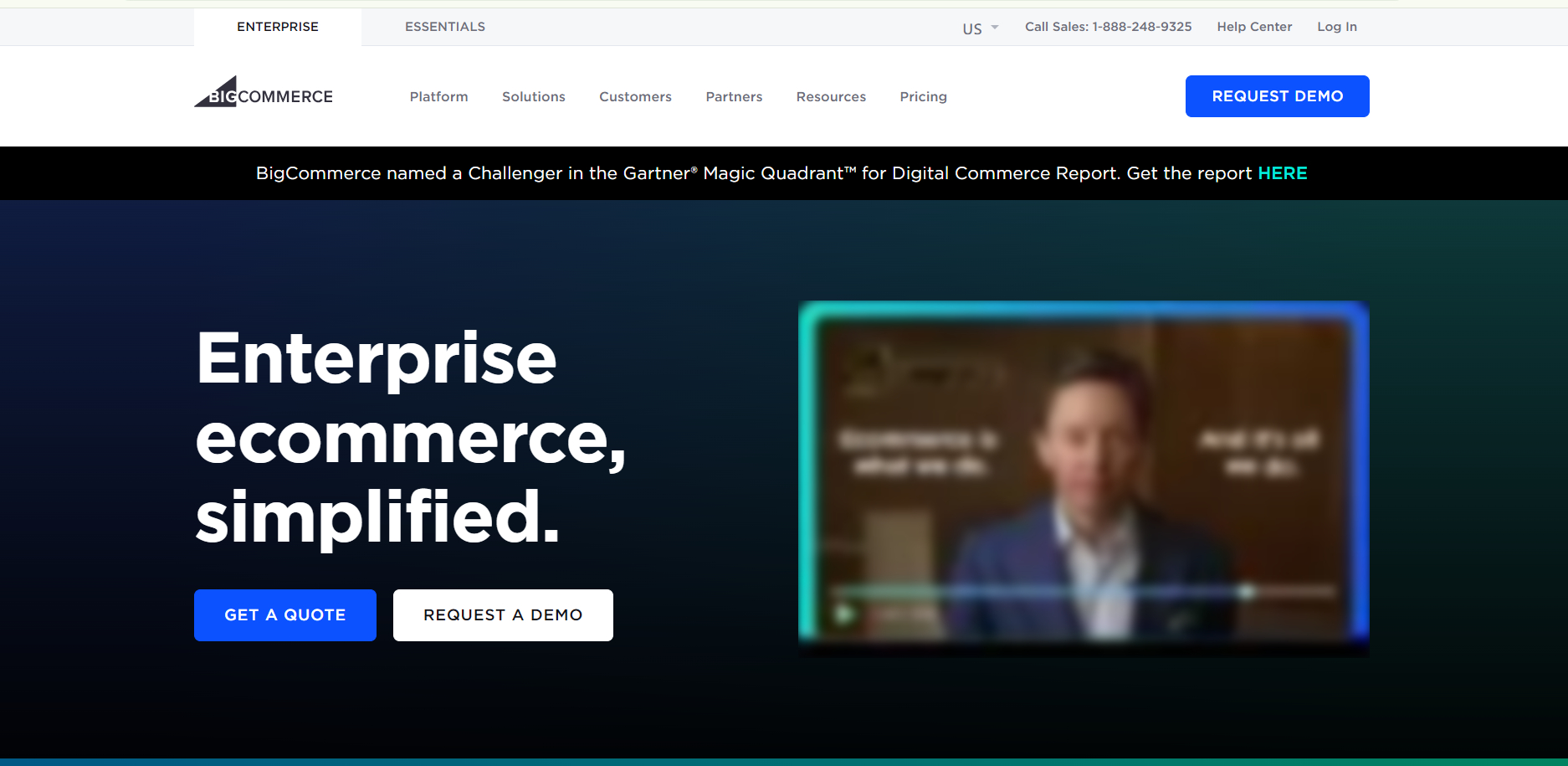
BigCommerce is a leading omnichannel ecommerce platform that helps companies create and run their online stores effectively. BigCommerce enables companies to provide consistent purchasing experiences across a variety of channels thanks to its extensive feature set and easy integration possibilities.
Features
Platform that is adaptable and expandable to suit companies of all sizes
An extensive feature set for order, inventory, and customer data management
Integration for a wider audience with well-known markets and social media platforms
Advanced analytics and marketing technologies to boost sales and expansion
Resources and prompt customer service to help with implementation and optimization
Omnisend
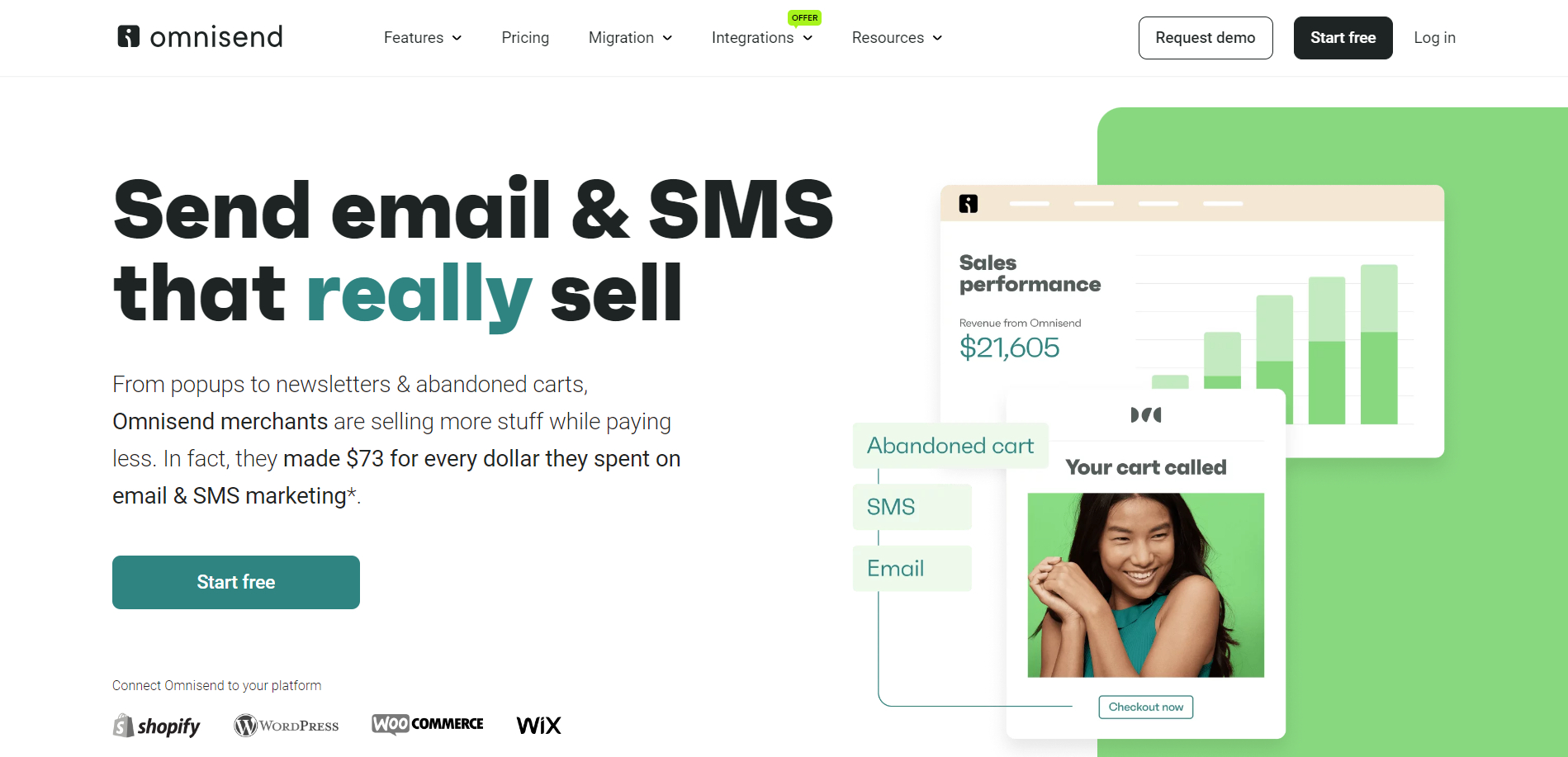
Omnisend is an omnichannel platform for ecommerce that automates sales and boosts customer engagement. It enhances targeting and campaign efficiency with customer data analysis, and offers multi-channel communication through texts, emails, and push notifications. Pre-made templates and A/B testing simplify campaign management and optimization.
Features
The email builder and template library can be dropped and dragged.
Pre-made workflows for ecommerce.
Drip marketing initiatives.
Advanced campaign reports available on a sales dashboard.
Conclusion
Businesses need to provide customers with seamless experiences across all channels in today's digital age. Platforms that are omnichannel offer complete solutions for effective customer relationship management. It can be difficult to select the best platform when there are so many possibilities. We hope that this essay has assisted you in making a decision. Continue looking into and studying the top omnichannel solutions to find out more about how to improve customer experiences and increase revenue.
VISIT: Best Omnichannel Ecommerce Solutions
{{post.actCounts.r_count}}
Reaction
Reactions
{{post.actCounts.c_count}}
Comment
Comments
{{post.actCounts.s_count}}
Share
Shares
Insights
{{comment.cm_u_name}}
Cancel
Edit
Delete
{{comment.actCounts.r_count}}
Reaction
Reactions
{{comment.actCounts.c_count}}
Reply
Replies
{{subComment.cm_u_name}}
Cancel
Edit
Delete
{{subComment.actCounts.r_count}}
Reaction
Reactions
{{subComment.actCounts.c_count}}
Reply
Replies
See Older Replies
Loading Comments
No More Replies
See Older Comments
Loading Comments
No More Comments
List of issues.







.png)






